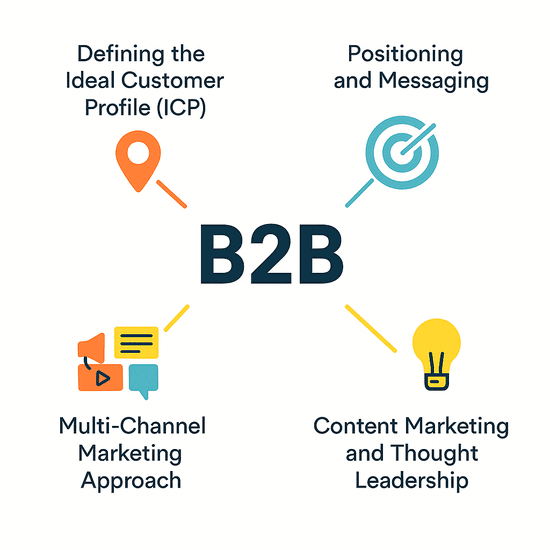In the modern business world, we hear the words “B2B Marketing” all the time. But what exactly does it refer to? What are its main components and, consequently, the best strategy to adopt?
When we talk about B2B marketing, short for business-to-business, we refer to the marketing process through which one business informs another about its products and services. Unlike B2C marketing (business-to-consumer), B2B targets decision-makers within organizations – not individual consumers. This means strategies must be oriented toward long-term, trust-based relationships with a strong and clear focus on ROI, performance tracking, and valuable, informative content.
In a competitive, digitally driven market, having a structured and data-informed marketing strategy is essential for positioning your business effectively. Let’s now dive into the key components that define a successful B2B strategy – and how data plays a vital role in powering it.
Core Components of a B2B Marketing Strategy

Defining the Ideal Customer Profile (ICP)
An Ideal Customer Profile (ICP) is a detailed description of the company that would benefit the most from your solution – and so provide the most value in return. This typically includes factors such as industry, company size, revenue, location, and decision-making structure. In B2B marketing, knowing exactly who you’re targeting is a fundamental, key element: it ensures that your messaging, campaigns, and sales efforts are aligned and efficient.
Positioning and Messaging
The way you choose to position your brand also defines how your solution stands out in a crowded marketplace. Effective B2B messaging should focus on business-critical outcomes like reducing costs, improving efficiency, increasing revenue, or reducing risk – while always keeping in mind the long-term objective.
Multi-Channel Marketing Approach
Successful B2B strategies leverage a mix of digital and offline channels, including:
- LinkedIn: for professional networking and paid advertising, accompanied by other social media platforms to reinforce the brand identity and visibility (e.g. Instagram, Facebook)
- Email campaigns and newsletters: to keep current and potential customers engaged and up to date
- Google Ads and SEO: to capture promising leads and increase reach
- Industry events and webinars: for thought leadership and relationship building, on a face-to-face level
It is important to make sure that each channel plays a clear role in the customer journey – and that you can measure performance accurately across them all, evaluating what works best for your company’s purposes.
Content Marketing and Thought Leadership
Finally, content represents the heart of B2B marketing. Use your website and media channels to prove your authority, trust, and expertise with educational blogs, in-depth whitepapers, case studies, and so on. By sharing insights that solve real business challenges, we position ourselves as a valuable partner – not just a service provider.
The Role of Data and Analytics in B2B Marketing – and at Digital Loop
Another key element to consider when building a B2B marketing strategy is data. In B2B, data and analytics are the foundation of an effective and scalable strategy, based on real numbers and concrete results.
Whether you’re launching a LinkedIn campaign, optimizing your SEO strategy, or personalizing an email follow-up flow, data is the element that ensures relevance, precision, and ROI. Tools like Google Analytics, CRM systems, and marketing automation platforms help you monitor user behaviour, segment audiences, and track what’s working – and what isn’t – across the entire process. On the other hand, data also serves as proof of your work when it comes to the relationship with the client, fostering trust based on solid ground and transparent, countable results.
However, collecting data isn’t enough – you also need to interpret and act on it. Many businesses struggle here, especially when managing multiple platforms or channels with limited integration between them. That’s why at Digital Loop we place such emphasis on privacy-compliant, consent-based data strategies, paired with clear dashboards and actionable metrics. We help our clients track what really matters: conversions, cost-efficiency, and long-term value – ethically and effectively.
So how do we put this approach into practice?
Here at Digital Loop, we deliver with a hands-on strategy. We actively participate in industry events to stay connected and exchange ideas face-to-face. We run SEO campaigns tailored to each client’s goals. We launch targeted cold email flows to reach the right people at the right time. And last but not least, we regularly share insights and thought leadership on LinkedIn to open up space for opinion sharing, updates, and guidance within the community.
But most importantly, what sets us apart is our custom MarTech solutions. Our tailored tools help our clients lead in competitive markets. For example, we’ve built an AI Overviews Analyzer – a tool designed to help our clients stay on top of what’s changing in Google’s AI Overviews and make smarter, faster decisions based on the continuous shifts we see happening every day.
Conclusion
To sum up, successful B2B marketing is about much more than publishing content or launching ad campaigns. It requires a structured yet flexible strategy – one that’s deeply informed by data, aligned with business goals, and responsive to an evolving market.
Start by defining your ideal customer. Get your message right. Pick the right platforms. Then test, track, and refine. No strategy is perfect from day one, but with the right mindset and tools, it can continuously improve.
Want to understand how AI-driven insights can boost your B2B marketing? Let’s talk, now.









